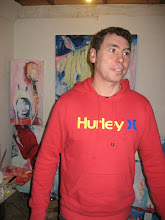IMAGE AND WORD
‘...to an ever greater extent our experience is governed by pictures, pictures in newspapers and magazines, on television and in the cinema’ 1. A quote from Douglas Crimp, who believed that our experience of reality is organised by the images we make of it. What Crimp fails to acknowledge is the importance of word.
I believe that image and word are inseparable and coexist side by side.
Are poetry and painting independent arts? W.J.T Mitchell asks in the first chapters of his book, Iconology: Image, Text, Ideology. Or are the image and word one because beneath word is image which is an impression of outward experience.
Mitchell questions what sense we can make of icons. He looks at whether there is a hierarchy between image and word.
Mitchell starts by quoting Mark Twain who believed that painting needed a title for explanation. That without one the art could be open to any number of interpretations. Twain refers to Guido Reni’s painting of Beatrice Cenci which he felt could just as easily be seen as ‘girl with hay fever; or young girl with her head in a bag’40. What, Twain fails to acknowledge is that the people of the time would have known the story and instantly recognised the figure? In the Renaissance symbols were used to tell stories in art they helped to tell the viewer what to think.
The problem is that painting cannot stand outside pictorial and verbal traditions. People want to see through the brain using words, symbols, or narrative. In other words brainwork is structured by language; we need words to structure our thinking. Therefore often the subtleties of art are overlooked. Francis Bacon said, “The task of painting is to render visible forces that are not themselves visible”2. Mitchell called it the ‘painting of the invisible’40. We can think of it as subtle levels of understanding, emotional experiences, and conveying ideas through the imagination.
The word and image are different modes of representation but they are two sides of the same coin. One is culture and the other is nature. The alienation between them is a modernist concern. A time of industrialization when those involved in all forms of art, felt traditional methods of expression were outdated. Modernist artists such as Cezanne, Picasso and Matisse wanted to move beyond Realism and focus on more subtle forms of narrative.
The struggle is not to heal the split between words and image but to allow them to work together to enable our understanding.
1. Colin Trodd, Postmodernism and Art, The Routledge Companion to Postmodernism, ed. Stuart Sim, London, Routledge, 1999. 91
2.
Subscribe to:
Post Comments (Atom)


In picking up on Mitchell's investigation into the existence of a heirarchy between image and word you seem to posit rather, and one I agree with to an extent, a co-existence between the two, regarding them as 'inseparable' and 'two sides of the same coin'. However I would depart from your's slightly to not regard such an inseparability between the two as a result of their being separate forces bought into the same conversation but rather that an image, different from a picture or photograph, exists as a linguistic construction itself..that is a product of language. In other words where you point out that we need words to structure our thinking..I would say it is within such a process that an image is constructed. Thus such an inseparability is reflective of the image as a product of linguistic definition.
ReplyDeleteSpeaking about how there is a hierarchy between image and word and photo sometimes fail to communicate; it’s maybe also because the words make more sense without a background or context and could also go explaining itself than images.
ReplyDelete